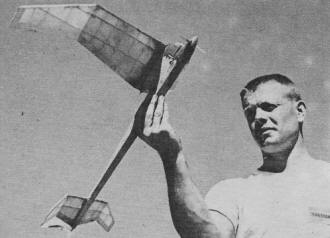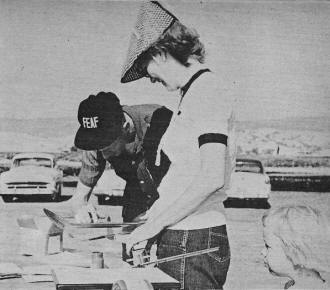|
The 1956 Annual edition of
Air Trails magazine reports here on the 1955 Air Force Model Airplane Championships
held at Travis Air Force Base, in California. Check out that B-29 control line model
entry, and then see this B-29
model inherited by Boyd Steffe. Back in the good 'ole days, the U.S. armed forces
spent taxpayer money supporting sporting events and hobby pursuits. It helped increase
morale, esprit de corps, technical prowess, physical fitness, and very importantly,
it promoted the service as a career and lifestyle. Both the Air Force and the Navy
were heavily into model aviation by sponsoring competitions on bases worldwide.
The Navy was a prime sponsor of the Academy of Model Aeronautics' Nationals competition
for many years, using its exposure to young men as a recruitment effort. Today,
sadly, such activity is looked upon by our Woke armed forces as White Privilege
and money is instead applied toward gender change operations and lifelong medical
and psychological support, and for children's reading time in base libraries, conducted
by transvestites. You think I'm making that up? Do a Google search.
1955 Air Force Model Airplane Championships at Travis
AFB

Fred Kantz and Bryant Thompson with their B-29 and C-119. Fred
took first in scale in A.F. world wide championships. Bryant was third; his model
also shown in "Nats" section.
By Dick Everett
Join the Air Force and enjoy modeling could well be the cry of recruiters today
... take Bob Lutker for instance
The 1955 Air Force Model Airplane Championships was indeed a contest for champions.
Blessed by better than average weather for Travis Air Force Base, the contestants
were given every chance to fly their ships but strictly to the rules.
Top flying was in the speed events where some very fast time was turned and one
record beaten. Piper Mason made fastest time, 149 plus in C, very closely pushed
by Jim Nightengale. Very fast time was also turned in A where Robert Riley posted
133 plus, slightly more than Nightengale turned in this event. Proto is where the
record was broken - Karl Caldwell turned 95 plus for a very good performance, slowed
somewhat by the wind which had come up just prior to his run.
In Half-A there were two runs of over 85 mph by Karl Caldwell and Eddie Vanlandinghan,
Caldwell winning out by a narrow margin. Piper Mason also won jet with a very good
145 plus.

Winner of towline glider event at 1955 AF championships was George
Howard who hails from Scotland but nevertheless is a right good USAF'er. George
here holds his FuBar free flight entry. At American Nats G.H. got longest traveler
award.

A/2C Bob Lutker, world's champion speed flyer, shown with M/Sgt
Harold D. Boyer, president of the Wheelus Field model airplane club. Bob started
contest modeling in a big way while stationed at this Tripoli, Libya, base of U.S.A.F.

Fred Kantz again with his Half-A free flight design which features
sharply swept wing tips. Engine is fully cowled, stabilizer tips are also swept
and drooped. Fine flyer.
Flying scale proved to be a very closely contested event with only 5 points separating
1st and 3rd. As it turned out, Fred Kantz, who was 3rd in scale points with his
B-29, flew to enough flight bonus points to beat out Arthur Loughton's P-38 and
Bryant Thompson's C-119.
The team racing event was won by Jack Nichols with a very fast 8 1/2 minutes
for the 140 laps, while David Yoder and S. W. Christian finished 2nd and 3rd. Bob
Chambers, who had won every heat race he was in, had the misfortune of having his
lines cut on take-off by another ship to end his chances. In combat Joseph Roslyns,
Jr. scored a kill in the first minute to win this event, three fellows tied for
2nd with 40 points, and two others for 3rd. J. E. Scott won stunt, with Don Longhofer
2nd and Bob Thomas 3rd.
There were no real high times in the free flight events due mostly to no one
flying early enough; the ships were plenty good. Half-A was probably the closest
when Keith Fulmer nosed out Bob Spaulding by 0.6 second, due to Bob's ship dethermalizing
early. There were no fuses allowed which caused some of the guys trouble; Spaulding
forgot his fuel when he went out to fly, the time consumed in getting it allowed
his dry ice to evaporate, leading to an early pop-up. In hand launch a real good
time of 11 minutes plus was turned in by Glen Howard.
Except for Half-A or American Class the PAA events did not have very many entries;
only one making a successful flight in Clipper Cargo was William E. Smith, Jr.,
while Jim Scarborough came through in the International Class. In the American Class
James J. Juliano was top man, closely followed by Karl Caldwell and Bob Kozuki.

Bryant Thompson finger-paints on his A.M.A. license number (as
required in rules) assisted by his wife. His daughter seems to be a little dubious
about the whole operation!
In A free flight W. J. Godden was first; in B, Bob Kozuki; in C, Charles Kelley.
The rubber event was closely contested with Charles Rushing finally winning out,
followed by Bob Chambers and Stuart Savage.
Radio Control was very easily won by Arthur Putze who put on a real good flight
with his Multi-Control model ending with a perfect on-the-spot landing.
Meet high point man was Karl Caldwell who garnered more than 600 points, almost
double his nearest competitor. Karl flew in both the free flight and the U-control
events. Some very fine prizes were awarded, topped by Air Force rings for the top
15 men. The first five received rings with a blue stone and two diamonds, the second
five rings with just the. blue stone, and the third five silver rings.
Typical Air Force modeler is Robert Lutker, 25. He is married and makes his home
in Forth Worth, Texas.
Lutker originally planned an engineering career for himself, but switched from
engineering to business administration at Texas Christian University after his family
purchased a florist shop in 1946.
Among Lutker's additional hobbies have been flying (he has soloed), hunting and
boat building. The last named he considers too expensive.
Lutker also stated his reason for joining the Air Force instead of Army, Navy
or Marines. The Air Force has a better model airplane program.
He started actual model competition in 1943 and has engaged in well over a hundred
events in the past 13 years. Before entering the Air Force, Lutker's competition
was confined chiefly to the Southwest where he entered meets throughout Texas and
as far north as Kansas. Since '52 he has extended this area to include Denver, Rapid
City, Chicago, Wiesbaden, Tripoli, Berlin, and The Hague.
Of all the meets he has competed in and trophies and medals he has won, Lutker
believes his most distinct thrill came at the FAI Meet at The Hague, Holland. There,
among the cream of international model airplane sportsmen, Lutker staked a small
claim to fame by taking first for the United States in the championship speed event.
Posted April 27, 2024
|